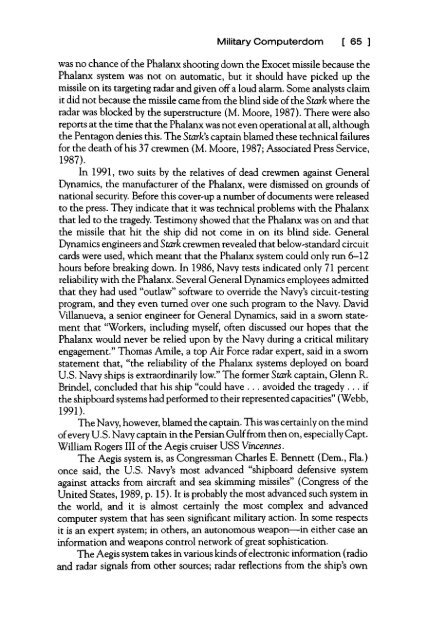entire book - Chris Hables Gray
entire book - Chris Hables Gray
entire book - Chris Hables Gray
You also want an ePaper? Increase the reach of your titles
YUMPU automatically turns print PDFs into web optimized ePapers that Google loves.
Military Computerdom [ 65 ]<br />
was no chance of the Phalanx shooting down the Exocet missile because the<br />
Phalanx system was not on automatic, but it should have picked up the<br />
missile on its targeting radar and given off a loud alarm. Some analysts claim<br />
it did not because the missile came from the blind side of the Stark where the<br />
radar was blocked by the superstructure (M. Moore, 1987). There were also<br />
reports at the time that the Phalanx was not even operational at all, although<br />
the Pentagon denies this. The Stork's captain blamed these technical failures<br />
for the death of his 37 crewmen (M. Moore, 1987; Associated Press Service,<br />
1987).<br />
In 1991, two suits by the relatives of dead crewmen against General<br />
Dynamics, the manufacturer of the Phalanx, were dismissed on grounds of<br />
national security. Before this cover-up a number of documents were released<br />
to the press. They indicate that it was technical problems with the Phalanx<br />
that led to the tragedy. Testimony showed that the Phalanx was on and that<br />
the missile that hit the ship did not come in on its blind side. General<br />
Dynamics engineers and Stark crewmen revealed that below-standard circuit<br />
cards were used, which meant that the Phalanx system could only run 6-12<br />
hours before breaking down. In 1986, Navy tests indicated only 71 percent<br />
reliability with the Phalanx. Several General Dynamics employees admitted<br />
that they had used "outlaw" software to override the Navy's circuit-testing<br />
program, and they even turned over one such program to the Navy. David<br />
Villanueva, a senior engineer for General Dynamics, said in a sworn statement<br />
that "Workers, including myself, often discussed our hopes that the<br />
Phalanx would never be relied upon by the Navy during a critical military<br />
engagement." Thomas Amile, a top Air Force radar expert, said in a sworn<br />
statement that, "the reliability of the Phalanx systems deployed on board<br />
U.S. Navy ships is extraordinarily low." The former Stark captain, Glenn R.<br />
Brindel, concluded that his ship "could have .. . avoided the tragedy ... if<br />
the shipboard systems had performed to their represented capacities" (Webb,<br />
1991).<br />
The Navy, however, blamed the captain. This was certainly on the mind<br />
of every U.S. Navy captain in the Persian Gulf from then on, especially Capt.<br />
William Rogers III of the Aegis cruiser USS Vincennes.<br />
The Aegis system is, as Congressman Charles E. Bennett (Dem., Fla.)<br />
once said, the U.S. Navy's most advanced "shipboard defensive system<br />
against attacks from aircraft and sea skimming missiles" (Congress of the<br />
United States, 1989, p. 15). It is probably the most advanced such system in<br />
the world, and it is almost certainly the most complex and advanced<br />
computer system that has seen significant military action. In some respects<br />
it is an expert system; in others, an autonomous weapon—in either case an<br />
information and weapons control network of great sophistication.<br />
The Aegis system takes in various kinds of electronic information (radio<br />
and radar signals from other sources; radar reflections from the ship's own








